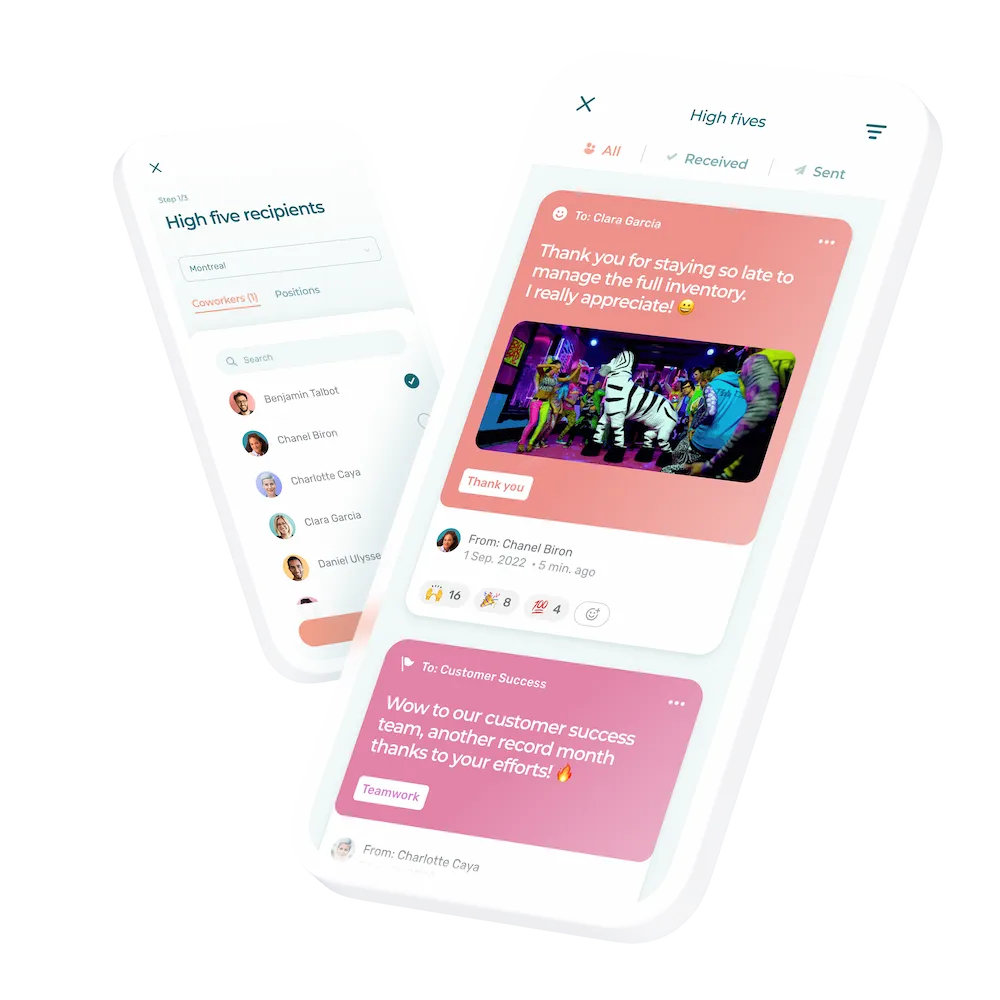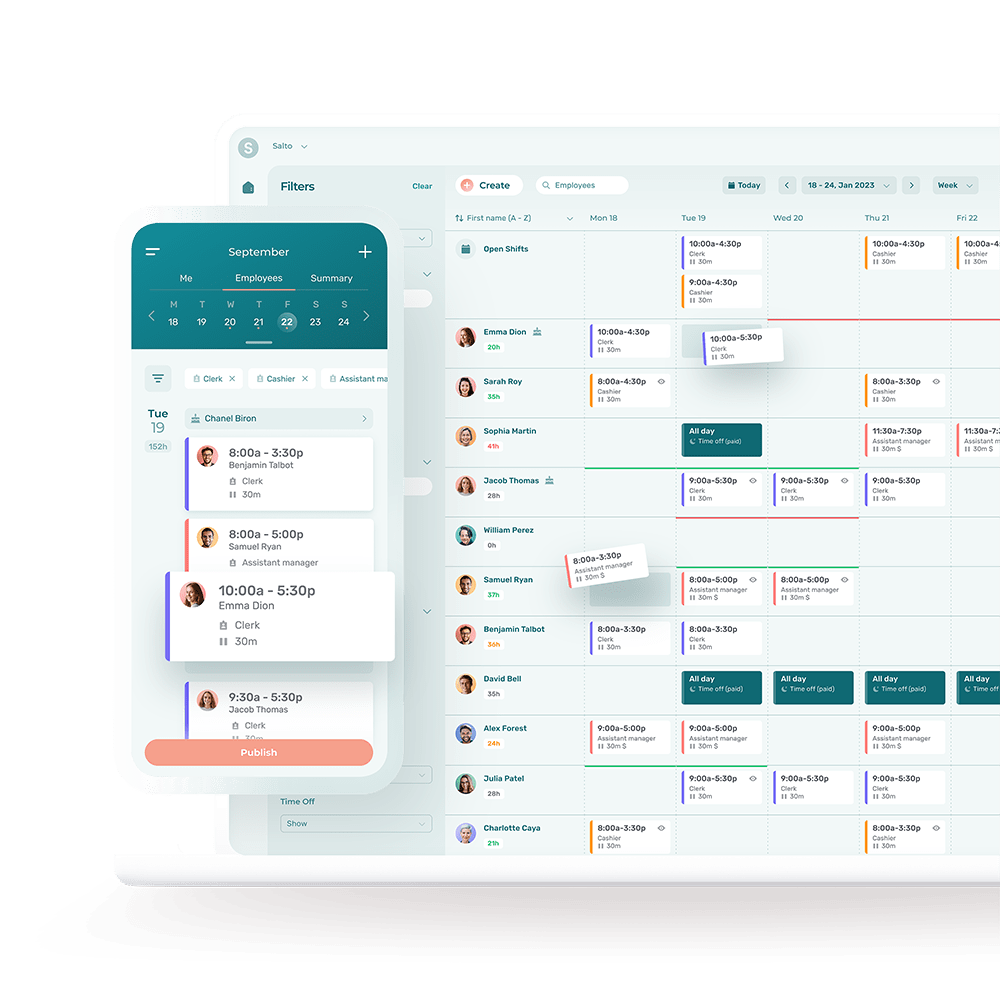Employee experience should be your top priority. After all, your team members are the lifeblood of your company, and their retention primarily depends on the employee experience you offer.
In today’s labor shortage we are all bombarded with concepts such as job satisfaction, employee engagement and staff retention—it’s easy to get overwhelmed. But at the end of the day, all these terms come down to the same basic idea.
Employee experience is a key part of employee satisfaction, and can help or hurt commitment and loyalty to an organization.
And employees aren’t the only ones who benefit from a focus on employee experience: a 2% increase in employee satisfaction has been found to lead to a 1% improvement in customer satisfaction.
Why Is Employee Experience So Important?
Employee experience encompasses an employee’s perceptions and impressions of their job and the company they work for. The concept describes their relationship to their work, including:
- The work environment
- Workplace relationships
- Salary and benefits
- Work-life balance
- Work tools
Employee experience refers to employees’ overall actual experience at the company, before, during and after the employment relationship. It encompasses the values, standards, behaviors, structures, processes and tools that make up employees’ daily lives.
10 Things You Can Do to Improve Your Employee Experience
1. Have a Clear and Engaging Corporate Mission and Values
What do an organization’s mission and values have to do with employee experience? 🤔
EVERYTHING!
When people buy into a cause, in this case a corporate mission and a set of values, they develop a strong sense of belonging and loyalty.
I can already hear you telling me that this isn’t as easy in your industry as it is for a community organization, for example.
Let’s take a grocery store. Could their mission be different from what one might initially expect? For example, employees might rally behind the mission of providing people with healthy, fresh, high-quality products in order to support their health and well-being. Now that’s an engaging mission.
Your company’s employees need to feel genuinely inspired to become true brand ambassadors. To achieve this, in addition to a clearly stated mission and values, there needs to be a match between the company’s values and those of the employees it hires. This is why it’s so important to conduct the recruitment process with care.
✨ Ideas for improving the employee experience by reinforcing your mission and values
- Post your mission and values in as many places as possible, so that your team reconnects with them on a regular basis.
- Use your social media to promote elements of your internal culture that reflect your mission and values. This raises your chances of attracting potential employees whose personalities and values match those of your team.
- Create traditions that reflect your values. Want to promote health on your team? Why not create a ritual of ordering a healthy lunch for the team every Tuesday?
2. Make Recognition a Standard Practice
Recognition is a powerful tool for engaging employees, and makes them feel like their work matters. It serves as a motivating force and directly impacts performance.
A British study has shown that a severe lack of recognition at work can increase the risk of cardiovascular disease by up to 1.7 times, and the risk of psychological distress by up to 1.9 times. 😨
Recognition extends to 4 areas: individuals, results, efforts, and quality of work.
🫶 Ideas for making recognition a part of your corporate culture
- Encourage your employees to say thank you or well done to their colleagues on the whiteboard in the staff room.
- Put a “kudos box” in your staff lounge and read the positive notes out loud at team meetings.
- Get into the habit of highlighting at least one achievement by each of your employees during your one-on-one meetings.
- Use software that makes it easy for co-workers to give each other recognition.
3. Give Employees as Much Autonomy as Possible
Autonomy at work commonly refers to the idea of initiative, discernment, individual organization, and even “freedom” in the workplace.
Letting employees develop autonomy enhances the employee experience, because they feel trusted, which directly impacts their self-confidence. Conversely, a lack of autonomy undermines professional esteem and can even generate distress at work.
I remember when my boss trusted me enough to let me close and open the restaurant where I worked. I was driven to do my best to prove that he had made the right decision. It was a win for both of us!
🚀 Ideas for improving the employee experience by giving more autonomy
- Give each of your employees at least one extra responsibility. For example, a grocery clerk can also be put in charge of organizing team-building activities, or a cashier can handle planning for community involvement for the rest of the team.
- Clarify your expectations and your team’s tasks, and let them know what resources are available to them.
- Ask your team members for their opinion when you have to make a decision that affects them.
4. Prioritize Interactions Between Colleagues
Human relationships are the linchpin of any company’s corporate culture. When you walk into a workplace with unhealthy or toxic relationships, you can sense the bad vibes right away… and the opposite is also true.
Positive relationships enrich the employee experience immeasurably while poorly managed conflicts in the workplace have been found to wreak havoc on motivation and, unsurprisingly, performance.
According to Gallup, having friends at work boosts employee satisfaction by 50%.
💬 Ideas for fostering relationships within your team
- Choose candidates with compatible personalities and values.
- Important: this being said, don’t fall into the trap of creating a homogeneous team at the expense of diversity, inclusion and equity.
- Regularly organize team-building activities.
- Encourage your employees to give each other recognition as this greatly contributes to appreciation among colleagues.
- Set aside a time each week for your team members to talk about their weekend or how they’re doing, so they can get to know each other.
- When onboarding a new employee, plan a team lunch where you can talk about things completely unrelated to work, so you can break the ice and allow colleagues to develop relationships.
5. Open a Dialogue With Your Employees
Relationships with immediate managers are an important part of the employee experience.
According to Marie-Claude Gaudet of the Université de Montréal’s School of Industrial Relations, “People who regularly supervise other people’s work have a key role to play in establishing a healthy work climate and healthy psychological conditions.” Isn’t this an extremely significant task?
In one of my student jobs, again in a restaurant, our immediate manager was condescending and very immature. He didn’t know how to be impartial and unfortunately, if he didn’t like certain employees, he seemed to enjoy singling them out and making fun of them in front of the rest of the team. In short, the experience there was completely different for different employees. For that reason alone, countless times I thought about leaving the team, even if the other aspects of the job were satisfactory.
🤝 Ideas for maintaining and building relationships with your employees
- Schedule one-on-ones with each of your employees on a regular basis, such as monthly.
- Take part in team-building activities and talk to your team (get to know them!).
- During onboarding, ask questions to break the ice with your new employees and get to know them as individuals.
- Send satisfaction polls to your team members, to find out how they perceive your relationship.
6. Be Flexible
Offering a flexible work environment helps not only to recruit the best candidates, but also to retain them. It should come as no surprise if your best employees leave because they’ve found an environment better suited to their needs.
One manager I know stubbornly insists that her team be at the office from 8 a.m. to 5 p.m., and categorically refuses the possibility of telecommuting, even for employees for whom it would be a possibility. She also requires written justifications for absences (appointments, sick children, etc.). This lack of flexibility puts pressure on employees and is hardly conducive to employee well-being.
Although flexibility is not just a matter of scheduling, this is an important component. Even for industries that don’t have the wiggle room for flexible schedules, flexibility in terms of time off and swapping shifts can be extremely interesting avenues.
⚖️ Ideas for giving your employees more flexibility
- Offer flexible working hours.
- Allow your employees to swap shifts when they’re unavailable.
- Be sure to let your team members take vacations.
- Respect your staff’s availability and even preferences.
- Offer wellness days that don’t require any justification.
7. Learn Exactly What Your Employees Want
There’s no better way to find out what someone wants than to ask them directly! Take it from us.
At Agendrix, we’re big fans of anonymous flash surveys. I’ll give you a very telling counterexample. In one of my previous jobs, the manager said she wanted to let her team disconnect at lunchtime, so she imposed a 1-hour unpaid break. The entire team complained about this—many would have preferred to take 30 minutes and end the day 30 minutes earlier.
If this manager had bothered to ask, she would have realized that her offer was out of alignment with her employees, and that she missed the mark!
😎 Ideas for finding out what your employees really think
- Measure job satisfaction with anonymous online polls or surveys.
- Schedule one-on-one meetings on a regular basis, and take advantage of them to really talk to your team members.
- Spend time on the floor with your team, to share in their realities.
- Put effort into building your relationship with your team: be vulnerable when the opportunity arises, and develop relationships based on authenticity.
8. Provide Sufficient Resources to Get Tasks Done
You’ve probably heard the expression “doing more with less.” This can be a helpful expression if we’re talking about minimalism in the home or fighting over-consumption. 😛 But when it comes to what managers ask of their teams… it’s another story.
Did you know that burnout and stress at work are frequently caused by an imbalance between available resources and expected results?
Employees need autonomy and they need people to trust in their abilities. But to realize their full potential, they also need to be given the training or tools they need to get the job done.
Providing your work team with sufficient resources will positively impact your employee experience, as it directly connects with psychological health at work.
🛠️ Ideas for providing your employees with the right resources
- Ask employees: “Do you have what you need to do your job properly?” “Do you feel exhausted or overworked?” “What would you need in order to work better?”
- Make sure you have enough employees on the floor during a shift.
- Avoid always asking the same dedicated, motivated individuals to take on more shifts, more customers and more responsibilities.
9. Develop a Culture of Training and Career Advancement
A recent LinkedIn study (the Workplace Learning Report) uncovered that 94% of employees would work for the same company longer if it invested in their professional training. The takeaway is that employee experience is shaped by employees’ ability to progress at work.
🤓 Ideas to enhance training and career advancement
- During performance reviews with your team members, ask them at least once a year about their expectations in the area of career advancement.
- Set aside a training budget.
- Offer your team a wide range of training courses to develop both personal and professional skills. Ultimately, all of these have an impact on work performance.
10. Focus On the Physical Work Environment
Your work environment should be attractive, ergonomic and safe.
Whatever your workplace or industry, it’s to your advantage to make your employees want to come to work.
🪴 Ideas for improving the employee experience by improving your workplace
Make sure your employees want to take their breaks and eat in the room designated for this purpose. To do so:
- Add plants to liven up the work environment;
- Paint the staff room in your corporate colors to reinforce a sense of belonging;
- Swap out neon for softer, cozier lighting;
- Provide your team with elements that will enhance their experience at work;
- At Agendrix, we have a chess set available to everyone in the dining room, and bookcases next to sofas in several places at the office.
Now it’s up to you to take action!
What 2 practices do you think you could easily implement in your workplace?











